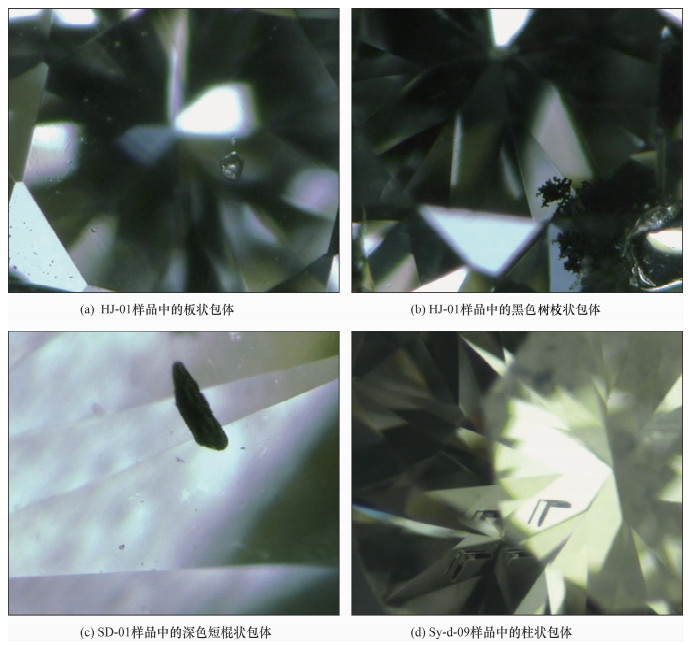The Spectral Characteristics and Identification Techniques for Colorless and Near-colorless HPHT Synthetic Diamonds
-
摘要: 实验室发现大量小颗粒的无色高温高压(HPHT)合成钻石与天然钻石混杂镶嵌在各种饰品中,前人提出荧光和磷光特征是主要的快速区分特征,然而荧光、磷光特征的差异并不能完全将HPHT合成钻石与天然钻石区分开来。本文将常规的宝石学观察分析与多种高精度谱学测试相结合,对五粒不同的无色-近无色HPHT合成钻石样品进行深入研究。结果表明,五粒钻石在紫外可见吸收光谱无270 nm吸收或是只有极弱的270 nm吸收,随着颜色级别的降低,270 nm吸收越明显。红外光谱测试显示,各粒样品中都含有不等量的硼元素。光致发光光谱测试表明,HPHT合成钻石含有与微量N、Ni、Si等相关的晶格缺陷。超短波紫外光源激发下,所有的HPHT合成钻石都有强磷光,在钻石观察仪下可以观测到清晰的八面体和立方体分区特征。显然,不同的合成钻石的特征略有差异,但综合其荧光及磷光特征以及红外、紫外、光致发光光谱特征,可以准确地将无色HPHT合成钻石与对应的天然钻石区分开来。Abstract: Melee-sized colorless HPHT synthetic diamonds mixed with natural diamonds in jewellery have been reported by gem testing laboratory. It was noted that the differences of the fluorescence and phosphorescence between natural and synthetic diamonds are the key features for quick screening in mixed diamonds. However, it is difficult to completely distinguish the two only by the differences of fluorescence and phosphorescence. In this paper, 5 colorless gem-quality HPHT synthetic diamonds were systematically investigated and characterized using mutiple spectroscopic techniques, together with traditional gem testing techniques. It was found that 5 samples display no, or weak, 270 nm absorption band at the UV-Vis spectra, and the lower the color grade, the stronger the 270 nm absorption band. Infrared absorption spectra showed that all samples contain boron. The photoluminescence spectra revealed that the colorless HPHT synthetic diamonds contain N, Ni or Si-related lattice defects. Under irradiation of the ultra-short wavelength light, all samples phosphoresced strongly with blue-green color. Typical octahedral and cubic growth patterns can be clearly observed under the DiamondViewTM imaging system. Although there are some differences between the samples, the HPHT synthetic diamonds can be accurately identified through careful analysis combining all features, particularly the spectral charateristics of phosphorescence and fluorescence, FTIR, UV-Vis, and photoluminescence spectra.
-

-
表 1 HPHT合成钻石样品的基本特征及特征峰位统计
Table 1. The characteristic lines in different HPHT synthetic diamond samples
参数 特征峰位 HJ-01 SD-01 NDT-01 Sy-d-08 Sy-d-09 净度级别 - SI1 SI1 VS1 VS1 SI1 颜色级别 - J E D E G 是否为磁铁吸引 - 是 是 否 否 是 紫外可见吸收光谱(nm) 270 明显 无 无 极弱 明显 红外光谱(cm-1) 4090 无 无 明显 明显 无 2800 弱 明显 明显 明显 弱 1344 有 未测得 未测得 未测得 未测得 1332 有 未测得 未测得 有 有 拉曼光致发光光谱(nm) 883 明显 无 无 极弱 中等 737 弱 无 无 无 弱 637 有 无 无 有 有 575 有 无 无 有 有 503 无 无 无 无 有 489 无 无 无 有 有 484 有 无 无 无 无 注:由于紫外可见光吸收和红外吸收都可称之为吸收峰,而光致发光则是发光峰,因此此处用特征峰来统称。 表 2 无色HPHT合成钻石、CVD合成钻石和天然无色钻石区分特征
Table 2. The characteristics of the colorless HPHT, CVD synthetic diamonds and natural diamonds
特征 HPHT合成无色钻石[1-2]
(IIa/IIb)CVD合成无色钻石[11]
(IIa)天然无色钻石
(Ia/IIa)HPHT处理天然无色钻石[13]
(IIa/IaB)微量元素(红外光谱) 含硼 不含硼 不含硼 不含硼 紫外可见吸收光谱 多数有270 nm吸收,少数高色级(D-E)无或具有弱270 nm吸收 多数有270 nm吸收,高色级(D-E)通常具弱或无270 nm吸收 几乎不可见270 nm吸收[13] 有些可检测到270 nm吸收 标准宝石用紫外灯 通常短波强于长波,黄色或黄绿色荧光 通常短波强于长波,黄色、橙色或黄绿色荧光 通常长波强于短波 无荧光或弱荧光 荧光特征
(DiamondView)灰蓝色,块状分区明显 橙色、绿色、蓝色、蓝绿或绿蓝色;平行层状生长纹 蓝色、蓝绿色、橙色等;四边形环带、网格状、带状等 蓝色 磷光特征
(DiamondView)几乎都有强磷光,少数弱或中等强度磷光。磷光颜色:蓝色、绿蓝色 多数具有中到强磷光,少数具弱到极弱或无磷光[16]。磷光颜色:蓝色、绿、绿蓝色等 一般无磷光,偶见弱蓝色、弱绿色等磷光,少见强磷光 无 光致发光光谱特征 多数有883 nm双峰,有些具弱737 nm发光峰 多数无883 nm发光峰,一般都有强度不等的737 nm发光峰 偶有弱883 nm发光峰,偶见弱的737 nm发光峰 无典型发光峰 异常双折射 无或弱 网格状、斑驳状或带状 网格状、斑驳状或带状 网格状、斑驳状或带状 磁性 有金属包体时可被磁铁吸引 无 无 无 -
[1] D'Haenens-Johansson U F S, Katrusha A, Moe K S, et al.Large Colorless HPHT Synthetic Diamonds from New Diamond Technology[J].Gems & Gemology, 2015, 51(3):260-279.
[2] D'Haenens-Johansson U F S, Moe K S, Johnson P, et al.Near-colorless HPHT Synthetic Diamonds from AOTC Group[J].Gems & Gemology, 2014, 50(1):2-14. https://www.researchgate.net/publication/276840774_Near-colorless_HPHT_synthetic_diamonds_from_AOTC_Group
[3] 兰延, 梁榕, 陆太进, 等.国内市场小颗粒无色高压高温合成钻石的鉴定特征[J].宝石和宝石学杂志, 2015, 17(5):12-16. http://www.cnki.com.cn/Article/CJFDTOTAL-BSHB201505002.htm
Lan Y, Liang R, Lu T J, et al. Identification Characteristics of Near-colourless Melee-sized HPHT Synthetic Diamond in Chinese Jewelry Market[J].Journal of Gems and Gemology, 2015, 17(5):12-16. http://www.cnki.com.cn/Article/CJFDTOTAL-BSHB201505002.htm
[4] Eaton-Magaña S, Post J, Heaney P J, et al.Using Phosphorescence as a Fingerprint for the Hope and Other Blue Diamonds[J].Geology, 2008, 36(1):83-86. doi: 10.1130/G24170A.1
[5] Howell D.Strain-induced Birefringence in Natural Diamond:A Review[J].European Journal of Mineralogy, 2012, 24(4):575-585. doi: 10.1127/0935-1221/2012/0024-2205
[6] Pinto H, Jones R.Theory of the Birefringence due to Dislocations in Single Crystal CVD Diamond[J].Journal of Physics:Condensed Matter, 2009, 21(36):1-7. http://www.researchgate.net/publication/51562534_Theory_of_the_birefringence_due_to_dislocations_in_single_crystal_CVD_diamond
[7] Chriostopher M W, Martin C, Paul M S.De Beers Natural versus Synthetic Diamond Verification Instruments[J].Gems & Gemology, 1996, 32(3):156-169.
[8] Šcajev P, Trinkler L, Berzina B, et al.Influence of Boron on Donor-Acceptor Pair Recombination in Type Ⅱa HPHT Diamonds[J].Diamond and Related Materials, 2013, 36:35-43. http://www.sciencedirect.com/science/article/pii/S0925963513000678
[9] Eaton-Magaña S, Lu R.Phosphorescence in Type Ⅱb Diamonds[J].Diamond and Related Materials, 2011, 20(7):983-989. doi: 10.1016/j.diamond.2011.05.007
[10] Watanabe K, Lawson S C, Isoya J, et al.Phosphorescence in High-pressure Synthetic Diamond[J].Diamond and Related Materials, 1997, 6(1):99-106. doi: 10.1016/S0925-9635(96)00764-9
[11] Wang W, Moe K S.Lab Notes:Silicon-vacancy Defect in HPHT-grown Type Ⅱb Synthetic[J].Gems & Gemology, 2012, 48(4):304-305.
[12] King J M, Moses T M, Shigley J E, et al.Characterizing Natural-color Type Ⅱb Blue Diamonds[J].Gems & Gemology, 1998, 34(4):246-268.
[13] Fisher D, Spits R A.Spectroscopic Evidence of GE Pol HPHT-treated Natural Type Ⅱa Diamonds[J].Gems & Gemology, 2000, 36(1):42-49. http://www.gia.edu/gems-gemology/spring-2000-hpht-treated-type-iia-diamonds-fisher
[14] Smith C P, Bosshart G, Ponahlo J, et al.GE POL Diamonds:Before and After[J].Gems & Gemology, 2000, 36(3):192-215. http://www.gia.edu/gems-gemology/fall-2000-ge-pol-diamonds-smith
[15] Lawson S C, Fisher D, Hunt D C, et al.On the Existence of Positively Charged Single-substitutional Nitrogen in Diamond[J].Journal of Physics:Condensed Materials, 1998, 10(27):6171-6180. doi: 10.1088/0953-8984/10/27/016
[16] 宋中华, 陆太进, 苏隽, 等.光致变色CVD合成钻石的特征[J].宝石和宝石学杂志, 2016, 18(1):1-5. http://www.cnki.com.cn/Article/CJFDTOTAL-BSHB201601003.htm
Song Z H, Lu T J, Su J, et al. Silicon-doped CVD Synthetic Diamond with Photochromic Effect[J].Journal of Gems and Gemology, 2016, 18(1):1-5. http://www.cnki.com.cn/Article/CJFDTOTAL-BSHB201601003.htm
[17] Collins A T, Kanda H, Burns R C.The Segregation of Nickel-related Optical Centers in the Octahedral Growth Sectors of Synthetic Diamond[J].Philosophical Magazine Part B, 1990, 61(5):797-810. doi: 10.1080/13642819008207562
[18] Collins A T.The Characterizations of Point Defects in Diamond by Luminescence Spectroscopy[J].Diamond and Related Materials, 1992, 1(5-6):457-469. doi: 10.1016/0925-9635(92)90146-F
[19] Nazar M H, Mason P W, Watkins G D, et al.Optical Detection of Magnetic Resonance of Nitrogen and Nickel in High-pressure Synthetic Diamond[J].Physical Review B, 1995, 51(23):16741-16745. doi: 10.1103/PhysRevB.51.16741
[20] Zaitsev A M.Optical Properties of Diamond-A Data Handbook[M].Berlin:Springer-Verlag, 2001.
[21] Collins A T.Colour Centres in Diamond[J].Journal of Gemmology, 1982, 18:37-75. doi: 10.15506/JoG.1982.18.1
[22] Breeding C M, Wang W.Occurrence of the Si-V Defect Center in Natural Colorless Gem Diamonds[J].Diamond and Related Materials, 2008, 17(7-10):1335-1344. doi: 10.1016/j.diamond.2008.01.075
[23] Lawson S C, Kanda H.An Annealing Study of Nickel Point Defects in High-pressure Synthetic Diamond[J].Journal of Applied Physics, 1993, 73(8):3967-3973. doi: 10.1063/1.352861
[24] Nazar M H, Neves A J, Davies G.Optical Studies of the 1.40eV Ni Center in Diamond[J].Physical Review B, 1991, 43(17):14196-14205. doi: 10.1103/PhysRevB.43.14196
-




 下载:
下载:


